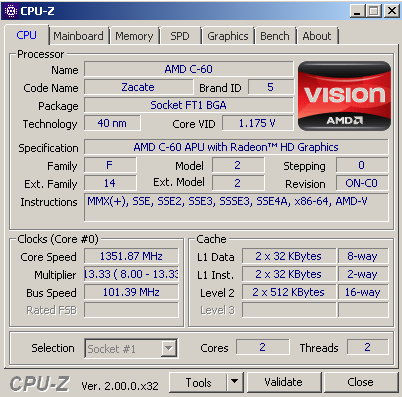Comparing: AMD C-60 vs Intel Core i9 11900F
In this comparison, we analyze two Processors: AMD C-60 and Intel Core i9 11900F, using synthetic benchmark tests to evaluate their overall performance. This side-by-side comparison helps users understand which hardware delivers better value, speed, and efficiency based on standardized testing. Whether you're building a new system or upgrading an existing one, this benchmark-driven evaluation offers valuable insights to guide your decision.
Specification Comparison Table
This specification comparison presents technical details of several devices or components to help you understand the key differences between each option. Use this table as a reference to determine which device best suits your needs.
| Specification | AMD C-60 | Intel Core i9 11900F |
|---|---|---|
| Architecture | x86 | x86 |
| Technology | 40 nm | 14 nm |
| Clock | 1 GHz - 1.3 GHz | 2.5 GHz - 5.2 GHz |
| Core/Thread | 2 / 2 | 8 / 16 |
| Segmen | Mobile | Desktop |
Submission Comparison Table
This submission comparison table displays the number and details of benchmark data submissions from various devices or components. This information helps you understand the performance based on the benchmarks that have been tested, as well as providing an overview of the consistency and popularity of the available benchmark results.
Submission Comparison Chart
This chart visualizes the benchmark scores comparison between two hardware devices based on submitted data.
Media Gallery
A collection of photos of tested hardware. These images can help you identify the physical form, model, and variant of the hardware in question. These photos are from our own documentation, and if they are not available we may not be able to document them.
About Hardware AMD C-60
Released in 2011, the AMD C-60 is a power-efficient processor from the Ontario series built on the Bobcat architecture. It has 2 cores and 2 threads, with a base speed of 1.0 GHz that can be increased to 1.33 GHz through Turbo Core technology. Designed specifically for portable devices such as netbooks and ultraportable laptops, the C-60 is focused on power efficiency and long battery life rather than high performance. With a TDP of just 9 watts, this processor enables ultra-thin and lightweight laptop designs without the need for complex active cooling systems. The main advantage of the C-60 is its extremely low power consumption, making it an attractive solution for users who need a lightweight computing device for daily activities with high mobility.
The AMD C-60 is also equipped with an integrated Radeon HD 6290 GPU, which has 80 shader cores and supports DirectX 11. Despite its modest specifications, this GPU is sufficient for multimedia purposes such as HD video playback, light graphics rendering, and old-school games with minimal graphics settings. However, overall, the performance of the AMD C-60 is limited and only suitable for light tasks such as browsing, typing documents, and using basic office applications. This processor will feel slow when used for heavy multitasking, modern software installation, or complex web-based applications. In tests using an Acer Aspire One 522 paired with 2GB DDR3 RAM and Windows 7 operating system, the processor was able to provide a decent user experience for basic needs, but was less responsive when compared to mainstream processors of the same generation. Even so, the AMD C-60 remains a viable solution for low-cost, power-efficient devices of its time.
Hardware Detail:
Device: Acer Aspire One 522
RAM: 2GB DDR3
OS: Windows 7
Friday, 08 April 2022 17:00:00 | Update: 1 month ago
About Hardware Intel Core i9 11900F
The Intel Core i9-11900F, launched in 2021, is a high-end desktop processor from the 11th generation Rocket Lake family. Featuring 8 cores and 16 threads, this CPU is built for users who demand strong single-core performance in tasks such as gaming, creative workloads, and professional applications. With a base clock speed of 2.5 GHz and a boost clock up to 5.2 GHz via Intel Turbo Boost Max Technology 3.0, the i9-11900F delivers fast responsiveness and excellent performance in lightly threaded scenarios.
Manufactured on the 14nm process, the i9-11900F introduces architectural improvements over its predecessor, including a significant IPC (Instructions Per Cycle) gain, thanks to the new Cypress Cove core design. However, despite these gains, the reliance on the older 14nm node leads to higher power consumption and lower efficiency compared to AMD’s Ryzen 5000 series built on 7nm technology—especially in sustained multi-threaded workloads.
As an “F” series processor, the i9-11900F lacks integrated graphics, meaning it requires a dedicated GPU to operate. This makes it a better fit for gaming PCs or professional workstations that already include a discrete graphics card. While this may not be ideal for users seeking basic systems without a GPU, it allows Intel to price the CPU more competitively.
In benchmarks and real-world performance tests, the Core i9-11900F excels in gaming, offering frame rates comparable to top-tier CPUs when paired with a modern graphics card. It also performs well in productivity tasks such as photo editing, software development, and video rendering—though users working with highly threaded applications might benefit more from CPUs with higher core counts.
Overall, the Intel Core i9-11900F is a solid choice for enthusiast builders, gamers, and users looking for top-tier single-core performance, but it may not be the most efficient option for heavy multitasking or rendering workloads when compared to newer multi-core CPUs.
Monday, 20 June 2022 07:37:04 | Update: 1 month ago



